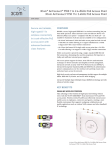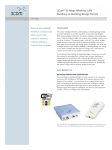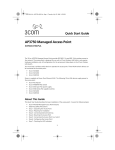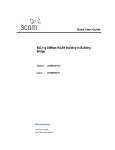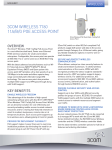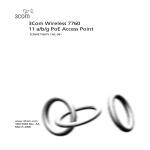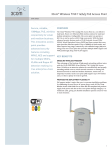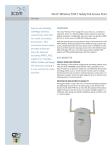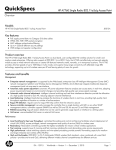Download 3Com 9150 Network Router User Manual
Transcript
3Com® AirConnect® 9550 11n 2.4+5GHz PoE Access Point 3Com® AirConnect® 9150 11n 2.4GHz PoE Access Point User Guide www.3com.com Part number: 10016853 USER GUIDE,AIRCONNECT 9550/9150 11N 2.4/5GHZ AP M/N: WL-605 / WL-604 Published June 2008 3Com Corporation 350 Campus Drive Marlborough, MA 01752-3064 Copyright © 2008, 3Com Corporation. All rights reserved. No part of this documentation may be reproduced in any form or by any means or used to make any derivative work (such as translation, transformation, or adaptation) without written permission from 3Com Corporation. 3Com Corporation reserves the right to revise this documentation and to make changes in content from time to time without obligation on the part of 3Com Corporation to provide notification of such revision or change. 3Com Corporation provides this documentation without warranty, term, or condition of any kind, implied or expressed, including, but not limited to, the implied warranties, terms or conditions of merchantability, satisfactory quality, and fitness for a particular purpose. 3Com may make improvements or changes in the product(s) and/or the program(s) described in this documentation at any time. If there is any software on removable media described in this documentation, it is furnished under a license agreement included with the product as a separate document, in the hard copy documentation, or on the removable media in a directory file named LICENSE.TXT or !LICENSE.TXT. If you are unable to locate a copy, contact 3Com and a copy will be provided to you. UNITED STATES GOVERNMENT LEGEND If you are a United States government agency, then this documentation and the software described herein are provided to you subject to the following: All technical data and computer software are commercial in nature and developed solely at private expense. Software is delivered as “Commercial Computer Software” as defined in DFARS 252.227-7014 (June 1995) or as a “commercial item” as defined in FAR 2.101(a) and as such is provided with only such rights as are provided in 3Com’s standard commercial license for the Software. Technical data is provided with limited rights only as provided in DFAR 252.227-7015 (Nov 1995) or FAR 52.227-14 (June 1987), whichever is applicable. You agree not to remove or deface any portion of any legend provided on any licensed program or documentation contained in, or delivered to you in conjunction with, this User Guide. Unless otherwise indicated, 3Com registered trademarks are registered in the United States and may or may not be registered in other countries. 3Com and the 3Com logo are registered trademarks of 3Com Corporation. Microsoft, Windows, Windows 2000, Windows XP and Windows Vista are registered trademarks of Microsoft Corporation. IEEE and 802 are registered trademarks of the Institute of Electrical and Electronics Engineers, Inc. All other company and product names may be trademarks of the respective companies with which they are associated. ENVIRONMENTAL STATEMENT It is the policy of 3Com Corporation to be environmentally-friendly in all operations. To uphold our policy, we are committed to: Establishing environmental performance standards that comply with national legislation and regulations. Conserving energy, materials and natural resources in all operations. Reducing the waste generated by all operations. Ensuring that all waste conforms to recognized environmental standards. Maximizing the recyclable and reusable content of all products. Ensuring that all products can be recycled, reused and disposed of safely. Ensuring that all products are labeled according to recognized environmental standards. Improving our environmental record on a continual basis. End of Life Statement 3Com processes allow for the recovery, reclamation and safe disposal of all end-of-life electronic components. Regulated Materials Statement 3Com products do not contain any hazardous or ozone-depleting material. Environmental Statement about the Documentation The documentation for this product is printed on paper that comes from sustainable, managed forests; it is fully biodegradable and recyclable, and is completely chlorine-free. The varnish is environmentally-friendly, and the inks are vegetable-based with a low heavy-metal content. INTRODUCTION Key Product Features ......................................................................... 7 Security ....................................................................................... 7 Performance and Reliability.......................................................... 8 Manageability.............................................................................. 8 Wireless Network Standards ........................................................ 9 802.11a................................................................................. 9 802.11b/g............................................................................ 10 IEEE 802.3af ........................................................................ 11 Installing Your 3com Wireless Access Point................................. 12 CONFIGURING THE WIRELESS ACCESS POINT Networks with a DHCP Server.......................................................... 13 Networks without a DHCP Server .................................................... 14 Launch the 3Com Wireless Infrastructure Device Manager (Widman) utility ......................................................................................... 15 Launching the 3Com Wireless Infrastructure Device Manager 15 First Time Only ..................................................................... 19 System Status .................................................................................. 19 System Summary ....................................................................... 19 Wireless Station List ................................................................... 21 Event Log List............................................................................. System Configuration ...................................................................... Setup Wizard ............................................................................. System Properties....................................................................... Access Point mode ............................................................... Wireless Bridge Mode........................................................... IP Settings .................................................................................. Wireless Network ....................................................................... Wireless Mode ..................................................................... Standard Channel ................................................................ Current Profiles .................................................................... SSID ..................................................................................... BSSID ................................................................................... Suppressed SSID................................................................... VLAN ID ............................................................................... Station Separation................................................................ Security ................................................................................ WEP ..................................................................................... WPA Only............................................................................. WPA2-Only .......................................................................... WPA2-Mixed ........................................................................ 22 23 23 26 27 27 28 29 30 30 30 32 32 32 32 32 33 33 34 35 36 Profile (SSID) Isolation .......................................................... WDS Link Settings ..................................................................... WDS Security Settings................................................................ Wireless Advanced Settings ....................................................... Transmit Power .................................................................... Beacon Interval .................................................................... Data Beacon Rate ................................................................ Association Timeout............................................................. Fragment Length ................................................................. RTS/CTS Threshold ............................................................... 802.11d support.................................................................. Distance............................................................................... Antenna Type....................................................................... Aggregation Support ........................................................... QoS ..................................................................................... Service............................................................................................. Management VLAN ................................................................... IAPP........................................................................................... 802.11F (IAPP) Support ........................................................ Ack-Policy ............................................................................ SNTP.......................................................................................... 36 36 38 39 39 40 40 40 40 40 41 41 41 41 42 43 43 44 44 46 48 Syslog Function................................................................................ System Log ................................................................................ Syslog Server.............................................................................. Syslog Port ................................................................................. Syslog Level................................................................................ Management ................................................................................... Administration ........................................................................... SNMP ........................................................................................ MAC Filtering............................................................................. Rogue AP Detection ................................................................... Backup/ Restore Settings ............................................................ Firmware Auto Upgrade............................................................. Firmware Manual Upgrade......................................................... Rebooting .................................................................................. Connecting Through the Com Port .................................................. Restoring Factory Settings ................................................................ 50 50 51 51 51 52 52 53 54 55 56 57 58 60 61 62 TROUBLESHOOTING Diagnosing Problems ....................................................................... 63 OBTAINING SUPPORT FOR YOUR 3COM PRODUCT Telephone Technical Support and Repair .......................................... 68 END-USER LICENSE AGREEMENT APPENDIX Antennas Used per Mode ................................................................ 72 Console Cable Pin-out ..................................................................... 74 INDEX 1 INTRODUCTION The 3Com AirConnect 9550 11n 2.4+5GHz PoE Access Point and the 3Com AirConnect 9150 11n 2.4GHz PoE Access Point are high performance access points that allow you to join isolated wired Ethernet networks into a unified wireless local area network (WLAN). The Access Point (AP) supports Wi-Fi Protected Access security standards to provide a higher level of security for network data and communications. The AP is also fully compatible with IEEE 802.11a (the 9550 AP only), 802.11b, 802.11g, and 802.11n. Key Product Features The product operates using 11a (9550 AP only), 11b, 11g, or 11n modes. This AP creates an enterprise-class wireless LAN, supporting up to 64 simultaneous users. Security 3Com offers one of the most robust suites of standards-based security on the market today. To protect sensitive data broadcast over the wireless LAN, 3Com supports Wireless Equivalent Privacy (WEP) and Wi-Fi Protected Access (WPA and WPA2). 8 Key Product Features 3Com strengthens this basic security mechanism with additional security features, including MAC address access control lists, IEEE 802.1x per-port user authentication with RADIUS server authentication support, Temporal Key Integrity Protocol (TKIP), Advanced Encryption Standard (AES), Wireless Protected Access (WPA) and Extensible Authentication Protocol (EAP) support: EAP-MD5, EAP-TLS, EAP-TTLS, and PEAP. Performance and Reliability 3Com wireless access point performance features ensure reliable and seamless connections for users wherever they roam. Automatic channel selection automatically finds the least loaded channel for interference-free communication. Auto network connect and dynamic rate shifting keep users connected through a wide variety of conditions by changing to the optimum connection speed as they move through the network. Manageability 3Com offers a wide range of standards-based management support, from SNMP to 3Com Network Supervisor and HP OpenView for seamless integration with your wired network. Wireless Infrastructure Device Manager and Wireless LAN Device Discovery tools let you configure parameters, run diagnostics, backup and restore configurations, and monitor performance from anywhere on the network using an embedded web server browser. Key Product Features 9 With Power over Ethernet (PoE) support, the same Category 5 cable that connects your access point to the data network also provides its power. A single cable installation dramatically improves your choice of mounting configurations because you no longer need to consider AC power outlet locations. PoE support makes it easier than ever to overcome installation problems with difficult-to-wire or hard-to-reach locations. Wireless Network Standards Understanding the characteristics of the 802.11a and 802.11g standards can help you make the best choice for your wireless implementation plans. 802.11a Ratified in 2002, 802.11a operates at the 5GHz band and supports data rates at up to 54Mbps. Because there are fewer devices in the 5GHz band, there’s less potential for RF interference. However, because it is at an entirely different radio spectrum, it is not compatible with 802.11b and 802.11g. The higher spectrum provides about 50m (164ft) of coverage. Consider 802.11a when you need high throughput in a confined space and you are: ■ Running high-bandwidth applications like voice, video, or multimedia over a wireless network that can benefit from a five-fold increase in data throughput. 10 Key Product Features ■ Transferring large files like computer-aided design files, preprint publishing documents or graphics files, such as MRI scans for medical applications that demand additional bandwidth. ■ Supporting a dense user base confined to a small coverage area. Because 802.11a has a greater number of non-overlapping channels, you can pack more wireless devices in a tighter space. 802.11b/g 802.11b, 802.11g and 802.11n all operate in the 2.4GHz band. 802.11b can support data rate up to 11Mbps. 802.11g can support data rate up to 54Mbps. 802.11n can support data rate up to 300Mbps.They all support the widest coverage – up to 100m (328ft). It is however, subject to a greater risk of radio interference because it operates in the more popular 2.4GHz band. Consider 802.11n when you need wider coverage and vendor compatibility and you are: ■ Maintaining support for existing 802.11b and 802.11g users and the existing wireless investment while providing for expansion into 802.11n. ■ Implementing a complete wireless LAN solution, including Ethernet Adapters, gateways, access points and clients; Wi-Fi certification guarantees compatibility among vendors. Key Product Features ■ 11 Providing access to hot spots in public spaces such as coffee shops or university cafeterias. IEEE 802.3af The IEEE 802.3af-2003 Power over Ethernet (PoE) standard defines terminology to describe a port that acts as a power source (PSE) to a powered device (PD). The IEEE 802.3af standard states that power may be delivered by an end-point PSE, using either the active data wires of an Ethernet port or the spare wires, to a powered device. An end-point PSE, such as a Power over Ethernet capable Ethernet switch, may implement either scheme. If a mid-span PSE is used, then the mid-span PSE can only implement power delivery over the spare pairs of the copper cabling and cannot be used to deliver PoE over 1000BASE-T connections. It should be noted that even if a device supports both methods of providing power, only one mechanism may be used to deliver power to a powered device. The first mechanism is to use the data pairs (pins 1, 2 & 3, 6) to transmit power, which is sometimes referred to as "phantom" power. The second power delivery mechanism is to use the unused, from a 10/100BASE-T perspective, pairs (pins 4, 5 & 7, 8) to deliver power that is supported within mid-span power delivery. 12 Key Product Features Installing Your 3com Wireless Access Point To set up and install your 3Com Wireless Access Point, please refer to the 3Com® AirConnect® 9550 11n 2.4+5GHz PoE Access Point 3CRWE955075 / WL-605 3Com® AirConnect® 9150 11n 2.4GHz PoE Access Point 3CRWE915075 / WL-604 Quick Start Guide (Part Number 10016854). Networks with a DHCP Server 2 13 CONFIGURING THE WIRELESS ACCESS POINT If the default AP configuration does not meet your network requirements, or if you want to customize the settings for your own network, you can use these tools to change the configuration: ■ Launch the 3Com Wireless Infrastructure Device Manager (Widman) utility ■ Directly connect to the device through its Ethernet port or console port Networks with a DHCP Server If your network has a DHCP server, an IP address is automatically assigned to the AP. It takes between one and two minutes for the Access Point to determine if there is a DHCP server on the network. Use the 3Com Wireless Infrastructure Device Manager (Widman) included on the 3Com Installation CD to locate the Access Point on the network and view its IP address. 14 Networks without a DHCP Server After you determine the AP’s IP address, you can enter that IP address into a web browser on a computer on the same subnet to view the Access Point’s system status or change its configuration. Networks without a DHCP Server If your network does not have a DHCP server, the Access Point uses a factory assigned IP address (169.254.2.111). You can use that IP address to configure the Access Point, or you can assign a new IP address to the Access Point. To verify that the Access Point is using the default IP address assigned at the factory: 1 Connect a computer directly to the Access Point using the supplied standard Category 5 UTP Ethernet cable. 2 Enter the Access Point’s default IP address (169.254.2.111) into the computer’s web browser. If the Configuration Management System starts, the Access Point is using the factory assigned IP address. You can configure the Access Point with the following login information: ■ Login name: admin ■ Password: password If the Configuration Management System does not start, the Access Point is on a different subnet than the computer. Install and start the 3Com Wireless Infrastructure Device Manager to discover the Access Point’s IP address. Networks without a DHCP Server 15 Launch the 3Com Wireless Infrastructure Device Manager (Widman) utility 1 Turn on the computer. 2 Insert the 3Com Installation CD into the CD-ROM drive. The CD will Autorun. If it does not Autorun, you can start the setup menu from the Windows Start menu. For example: Start > Run > d\:setup.exe. 3 In the menu click Tools and Utilities. 4 In the next screen, click the software you want to install. 5 Follow the on screen instructions to complete the installation. Reboot the computer if prompted to do so. Launching the 3Com Wireless Infrastructure Device Manager To be able to configure the Access Point you need to run the Wireless Infrastructure Device Manager. Go to Start > Programs > 3Com Wireless > Wireless Infrastructure Device Manager 16 Networks without a DHCP Server If the device is working correctly the following screen should be seen. Figure 1 3Com Wireless Infrastructure Device Manager Networks without a DHCP Server Click on the Properties button to see the following screen: Figure 2 Wireless Infrastructure Device Properties 17 18 Networks without a DHCP Server Directly connect to the device through its Ethernet port or console port. Follow the instructions below to log into the AP Configuration screen: 1 Load a web browser and enter http://169.254.2.111 2 The Log On screen appears Figure 3 Logon Screen To log on to the Web interface: 1 Username, type admin (case sensitive) 2 Password, type password 3 Click Log On. System Status 19 First Time Only After you have logged on for the first time you will be asked to select your country from the drop down menu. Figure 4 Country Selection System Status The Web interface has been designed to enable you to easily perform advanced configuration tasks and view information about the AP. System Summary After you click Log On from the Log On Screen, you’ll see the system status page on the screen. The System summary page is the default page that will pop up once you successfully log on. 20 System Status The system summary page shows all the configuration information about your AP, as shown in Figure 5. Figure 5 System Summary System Status 21 Wireless Station List Through the Wireless Station List page, you can easily identify the adjacent wireless stations. It will automatically observe the adjacent wireless station’s ID (if specified), MAC address, SSID and current status. Figure 6 Wireless Station List 22 System Status Event Log List The event log list stores a record of all the events within this designated WLAN. Figure 7 Event Log List System Configuration 23 System Configuration In this section, you will learn how to configure the basic functions of your AP. Setup Wizard The Setup Wizard will walk you through setting up the AP. To start the Setup Wizard, click Setup Wizard. 1 Figure 8 allows you to set up the following information: ■ SSID (Service Set Identifier) – This is the name of wireless network. Input 1-32 characters ■ Wireless Mode – Choose the required network mode from the drop down menu. ■ Standard Channel – Choose a channel from the drop down menu or select SmartSelect (recommended) to let the device select a channel. 24 System Configuration Figure 8 2.4G Radio Wireless Network 2 Click Next to continue the configuration or click Cancel to start again. 3 Figure 9 allows you to set up the following information: ■ IP Network Setting – Check to either obtain an IP address via DHCP or specify an IP Address manually. ■ IP Address – Enter the IP address that you want to assign. ■ IP Subnet Mask – Enter your networks subnet address. ■ Default Gateway – If used, enter the gateway address that the device should go through. System Configuration 25 Figure 9 IP Settings 4 Figure 10 allows you choose the security settings. Choose from the following settings in the drop down menu: ■ No security ■ WEP ■ WPA - Only ■ WPA2 - Only ■ WPA2 - Mixed 26 System Configuration Figure 10 2.4G Wireless Security Settings 5 Click Cancel to close without saving, click Finish to save the settings, or click Back to return to Figure 9. System Properties The System properties page allows you to define Device name, location, operation modes and Load Type. There are two operation modes to choose from: System Configuration 27 Access Point mode A Wireless LAN data transceiver that uses radio waves to connect a wired network with wireless station. Wireless Bridge Mode A wireless bridge connects two separate networks operating on the 802.11 standard. Figure 11 System Properties 28 System Configuration IP Settings This setting must match the network’s method of IP address assignment. Choose Dynamic Host Configuration Protocol (DHCP) or Static IP. With DHCP, IP addresses are assigned for predetermined periods of time. Choose Static IP if your network does not have an automatic system for IP address assignment. Figure 12 IP Settings System Configuration 29 Wireless Network The Wireless Access Point supports Multiple SSIDs which allows it to act as multiple APs appearing in a Wireless LAN network. You can configure up to 4 SSIDs on the device. Figure 13 Wireless Network 30 System Configuration Wireless Mode You can select your desired wireless operating mode from the drop-down box. Standard Channel Select the channel for your wireless LAN in Standard Channel block. The default setting is SmartSelect. It selects the channel which provides the best transmission quality. The available frequencies vary depending on which wireless mode you select. Current Profiles A maximum of four profiles can be configured. Check the Enable button to activate a profile. Click the Edit button to change its configuration. System Configuration Figure 14 SSID Profile Settings 31 32 System Configuration SSID Service Set Identifier. This is the assigned name for a wireless Wi-Fi network. Stations must use this unique identifier to communicate with an Access Point. The SSID can be any alphanumeric entry up to a maximum of 32 characters. BSSID Basic Service Set Identifier. This is the assigned MAC address of the station in the access point. This unique identifier is in Hex format. Suppressed SSID If you want to disable the broadcast of your SSID, you should check the Suppressed SSID box. It is also known as SSID Broadcast disable or Hide SSID. VLAN ID If your network uses VLANs, you can assign an SSID to a VLAN. Client devices using the SSID are grouped in that VLAN. Station Separation Enable Station Separation if you want to prevent stations connected to this profile from accessing each other. System Configuration 33 Security There are four levels of security available and all have differing properties: WEP Wired Equivalent Privacy data encryption provides data security. WEP Share Key authentication and WEP data encryption will block all but the most determined hacker. Figure 15 SSID Profile Settings 34 System Configuration 1 To add WEP, from the drop down list choose open-system or shared key authentication. 2 Select the desired input method (HEX or ASCII) 3 From the drop down list choose from 40/64, 104/128, 128/152 key lengths. WPA Only Wi-Fi Protected Access was constructed to provide improved data encryption, (which was weak in WEP), and to provide user authentication. Figure 16 SSID Profile Settings System Configuration 35 Only allows WPA clients to connect to the VAP. You can choose TKIP or AES as the encryption method The Group key update interval is configurable; the default value is 1800 seconds You can choose personal mode (PSK) or enterprise mode (802.1X) authentication The default is PSK. If you choose PSK, you will need to enter a pass phrase of 8-63 ASCII characters or 64 hexadecimal digits. If you choose 802.1X, you will need access to a RADIUS server, port and secret. WPA2-Only Only allows WPA 2 clients to connect to the VAP. You can choose TKIP or AES for the encryption method The Group key update interval is configurable, with a default value of 1800 seconds You can choose personal mode (PSK) or enterprise mode (802.1X) authentication. The default is PSK. If you choose PSK, you will need to enter a pass phrase of 8-63 ASCII characters or 64 hexadecimal digits. If you choose 802.1X, you will need access to a RADIUS server, port and secret. 36 System Configuration WPA2-Mixed Only allows WPA and WPA2 clients to connect to the VAP. You can choose TKIP or AES as the encryption method. The Group key update interval is configurable, with a default value of 1800 seconds. You can choose personal mode (PSK) or enterprise mode (802.1X) authentication. The default setting is PSK. If you choose PSK, you will need to enter a pass phrase of 8-63 ASCII characters or 64 hexadecimal digits. If you choose 802.1X, you will need access to a RADIUS server, port and secret. Profile (SSID) Isolation Stations connected to different profiles cannot access each other. Choose from No Isolation (Full access), or to Isolate all Profiles (SSIDs) from each other, check use VLAN (802.1Q) standard. WDS Link Settings Wireless Distribution System (WDS) allows access points to communicate with one another wirelessly in a standardized way. It can also simplify the network infrastructure by reducing the amount of cabling required. System Configuration 37 Figure 17 WDS Link Settings Supports up to 8 point to multipoint WDS links. Check Enable WDS and then Enable on the MAC addresses want to link to. Enter the MAC addresses of any other APs you want to link to. Example of a WDS topology: AP1 <-- WDS --> Master AP (our AP) <-- WDS --> AP3<-- WDS --> AP4 38 System Configuration WDS Security Settings Figure 18 WDS Security Settings Choose the required security level from: ■ None ■ WEP ■ WPA-PSK (TKIP) ■ WPA-PSK (AES) If using WEP security, enter the WEP key. If using WPA, enter the pass phrase. System Configuration 39 Wireless Advanced Settings To configure advanced wireless settings, click Wireless Advanced Settings. The toolbar and Wireless Advanced Settings menu appears. Figure 19 Wireless Advanced Settings Transmit Power Choose one of the following power levels: Full, Half (-3dB), Quarter (-6dB), Eighth (-9dB) or Minimum. The default is Full. 40 System Configuration Beacon Interval Choose an interval time between 25ms and 1000ms for each beacon transmission. The default is 100ms. Data Beacon Rate The Delivery Traffic Indication Message (DTIM). Specify the data beacon rate between 1 and 255. The default is 1. Association Timeout Set the value for the maximum time allowed for a wireless association to be established. When this time is exceeded, the connection is lost. The default value is 5 mins. Fragment Length Specify maximum packet size used for fragmentation. Packets larger than the size programmed in this field will be fragmented. The Fragment Threshold value must be larger than the RTS Threshold value. The default is 2346. RTS/CTS Threshold Request To Send threshold. Specify the packet size used to determine if it should use the CSMA/CA mechanism or the CSMA/CD mechanism. System Configuration 41 802.11d support 802.1d allows the device to communicate in areas where the 802.11 standard is not allowed. It adds features and restrictions to ensure compliance. Distance The maximum distance between client or AP and device. The default value is 1km. Antenna Type If you would like to use external antennas (to replace the original internal antennas), check External Antenna. Then specify one of the antenna types from the drop down menu, where the options are: ■ 3CWE591 3com 6/8dBi Dual-Band Omni Antenna ■ 3CWE596 3com 18/20dBi Dual-Band Panel Antenna ■ 3CWE598 3com 8/10dBi Dual-Band Panel Antenna Aggregation Support Sets the aggregation type: ■ A-MPDU : Aggregate MAC protocol data unit. ■ A-MSDU : Aggregate MAC service data unit. The default value is A-MPDU. 42 System Configuration QoS This section provides the administrator with the Quality of Service (QoS) data. The QoS setting is only available in AP Mode. The QoS Setting should be modified with caution because radio behavior is affected. These parameters can be modified when QoS service is Enabled. Service 43 Service Management VLAN If you reconfigure the Management VLAN ID, you may lose connectivity to the access point. Verify that the switch and DHCP server can support the reconfigured VLAN ID, and then re-connect to the new IP address. Figure 20 Management VLAN 44 Service IAPP Inter-Access Point Protocol (IAPP) Figure 21 IAPP 802.11F (IAPP) Support Choose either Enable or Disable IAPP allows multiple access points to communicate and pass location information about their associated stations. If you enable 802.11F support you should manually add BSSID/IP mapping: 1 Enter the BSSID and IP addresses of the AP. Service 2 45 Click Add Only stations roaming from one of the listed APs to this AP are allowed to re-associate with this AP. Others will be requested to go through the full association process. Figure 22 VME Parameters of Access Point 46 Service Ack-Policy When the Ack-Policy is checked. The device will not send ACK frames. The default value is disabled. Setting Min Contention Window Max Contention Window Fixed Slot Time Transmit Opportunity Limit Description For each access category, enter the minimum contention window value. Channel access is prioritized by assigning smaller contention window values to a higher priority traffic class. If a channel is busy or a transmission collides, a node chooses a random number between 0 and the current contention window minimum. For each access category, enter the maximum contention window value. The minimum contention window value is doubled each time a collision occurs until the maximum is reached. A small contention window value decreases the access delay but increases the probability of a collision. For each access category, enter the fixed slot time. Channel access can be strictly prioritized by assigning smaller contention window values to a higher priority traffic class. Traffic in the access category must wait for this fixed number of slots after each packet is received before resuming its random back-off. Enter the number of microseconds that qualified transmitters can transmit through the normal back-off procedure with a set of pending packets. Larger values allow a client to control the channel for longer periods of time, allowing it to achieve higher throughput in this access category at the expense of longer access times for all access categories. Service Setting Admission Control Description Note: In this release, clients are blocked from using an access category when they select Enable for Admission Control. The Admission Control check box controls client use of the access categories. When you enable admission control for an access category, clients associated to the access point must complete the WMM admission control procedure before they can use that access category. However, access points do not support the admission control procedure in this release, so clients cannot use the access category when you enable Admission Control. default : disable The default value table: AC TYPE AC_BK AC_BE AC_VI AC_VO (3) 47 Min Contention Window (2x-1; x can be 0-10) 4 4 3 Max Contention Window (2x-1; x can be 0-10) 10 6 4 2 3 Fixed Slot Time (0-15) Transmit Opportunity (0-65535 µS) 7 3 1 0 0 3008 (6016 when 11b) 1554 (3264 when 11b) 1 48 Service SNTP Simple Network Time Protocol (SNTP) allows the administrator to configure the network time settings. Figure 23 SNTP Service 49 The following settings can be configured. SNTP client enable/disable Set Time Timezone selection Daylight Saving Primary and Secondary SNTP server/port setting Click enable or disable. If it is disabled, the user has to input time manually. If it is enabled, the device will try to fetch time from configured SNTP servers. Specify Year, Month, Day, Hour, and Minute. These fields are grayed out and un-configurable if SNTP is enabled. This selection adjusts the time obtained from the SNTP server. Note: This selection does not affect manual time input as they are considered to be input at the same time. The start/end date of daylight saving changes automatically based on the time zone selection. Note: Start and End dates can be input manually, to avoid any regional policy changes. If SNTP is enabled, this device will try to fetch time from the Primary server first. The timeout for Primary NTP server is 5 seconds. If the Primary NTP server fails after 5 seconds the Secondary NTP server will be tried for 5 seconds. In the event that the Secondary server fails, the device will wait for 60 seconds before trying the Primary server again. This continues until a time is available. To avoid using an invalid NTP server address, this device stores the fetched/configured time. After it boots up, it uses the stored time first and adjusts time if time is fetched. 50 Syslog Function Syslog Function In the event of an error the device can send a message to a specified server. Figure 24 SysLog System Log Click either Enable or Disable to activate or deactivate the system log function. Syslog Function 51 Syslog Server Enter the IP address of the server that receives the error information. The default IP address is 0.0.0.0 Syslog Port Enter the port number that your server can be accessed by. The default port number is 514. Syslog Level Choose from the following levels, listed in order of severity of the detail to be recorded. The default setting is Error. ■ Emergency - System is unusable ■ Alert - Action must be taken immediately ■ Critical - Critical condition ■ Error - Error condition ■ Warning - Warning condition ■ Notice - Normal, but significant condition ■ Informational - Informational messages 52 Management Management This section describes how to use the management and information features of your Wireless Access Point. Administration In this section, you can change the user administrator name and password. The default Administrator name is admin (case sensitive), and password is password. Click Apply to save changes. Figure 25 Administration Management 53 SNMP Figure 26 SNMP The Simple Network Management Protocol (SNMP) administrative functions are changed through this screen. The following functions can be changed: ■ Enable/Disable SNMP ■ Contact info ■ Community names for read-only and read/write ■ Trap destination IP address ■ Community name 54 Management MAC Filtering Figure 27 Access Control List MAC filtering allows the administrator to filter MAC addresses of network cards that can access the access point. On this screen you can: ■ Enable/Disable filter ■ Change filter rule to allow or deny ■ Add/delete MAC addresses in the filter table This function is only available in AP mode. Management 55 Rogue AP Detection Figure 28 Rogue AP Detection Unspecified Access Points may try to access the network through this device. Rogue AP detection can prevent this. ■ Change Rogue AP definition. ■ Legal AP list - The list of allowed access points. ■ Detect rogue AP – All channels are scanned and Access Points without security, or not in legal AP, are considered rogue. This function is only available in AP mode. 56 Management Backup/ Restore Settings This screen allows the user to backup the Access Point’s current settings and restore back to the factory default. Once you have the Access Point working properly you should backup the information to have it available if something goes wrong. Figure 29 Backup/Restore Settings Management 57 Firmware Auto Upgrade The Wireless Access Point can auto upgrade the firmware if there is a newer version available. If you enable the Auto Upgrade function, the Wireless Access Point will automatically check for an updated version of firmware in the assigned FTP server for each time interval assigned. Remember to insert the correct FTP server IP address, username, password, and path to the FTP server. Figure 30 Firmware Auto Upgrade 58 Management Firmware Manual Upgrade On this screen, you can see the current firmware version of your AP. You can also manually upgrade your firmware by entering the path to your new firmware file. Figure 31 Firmware Upgrade Once you have chosen the upgrade file click Upgrade. Management Figure 32 Result 59 60 Management Rebooting You can reboot the Wireless access point from the browser interface. After you click reboot, the following window displays. Figure 33 Reboot After rebooting, the login page automatically displays. Connecting Through the Com Port 61 Connecting Through the Com Port Instead of using an IP address to configure the Access Point a Null modem cable, connected to the RJ-45 Console Port, can be used. In your terminal settings ensure that the following configuration is met: ■ Bits per Second – 15200 ■ Data Bits – 8 ■ Parity – None ■ Stop bits – 1 ■ Flow Control - none Once connected enter the user name and password. The default values are as follows: ■ Username: admin ■ Password: password Once logged in, type”?” for a list of commands. 62 Restoring Factory Settings Restoring Factory Settings The Access Point can be reset to the default factory settings either through the web browser (see “Backup/ Restore Settings” on page 56) or manually. To restore the settings manually, insert a pointed object (such as the end of a straightened paper clip) into the reset hole on the side of the Access Point, and hold for five seconds. Reset Hole Figure 34 Reset Hole Location Diagnosing Problems A 63 TROUBLESHOOTING Diagnosing Problems If you have difficulty with the Access point, try the following solutions. Symptom After you change the IP address, restore a backup configuration, or reset the Access Point to factory defaults, the Configuration Management System stops responding and you cannot continue configuring the Access point. If you change the IP address and click Apply, you cannot continue to configure the device using the old IP address. Similarly, after you restore a backup configuration or reset the Access Point to factory defaults, the IP address setting may be changed. Solution To recover from this situation and continue configuring the Access Point: 1 Close your browser. 64 Diagnosing Problems 2 Return to the 3Com Wireless Infrastructure Device Manager and click Refresh. 3 Select the device and click Configure to start a new configuration session and set its IP address. Symptom The Wireless Network Tree does not appear in the 3Com Wireless Infrastructure Device Manager window. Solution Verify that you are using the correct network adapter. In the device manager window, click Choose NIC. Select the network adapter for the network you want to scan, and click OK. Symptom The Access point has a yellow exclamation point (!) next to it in the Wireless Infrastructure Device Manager. Solution The Access Point is on a different subnet than the computer attempting to configure it. To recover from this situation and continue configuring the Access point: 1 Close your browser. 2 Return to the 3Com Wireless Infrastructure Device Manager and click Refresh. 3 Select the device and click Configure to start a new configuration session. Diagnosing Problems 4 65 Make sure the subnet address matches that of the computer. Symptom Two Access Points cannot communicate in ad-hoc mode. Solution Adjust the positions of the Access Points to improve reception. To ensure correct operation in ad-hoc mode, the settings on the two Access Points must match exactly. Launch the Access Point Configuration Management System and make sure that the Wireless LAN Service Area, channel selections, Data Preamble setting, and security setting are the same on both Access points. Symptom You are running Windows NT. After you connect the Access Point, your computer cannot obtain a valid IP address. Solution (s) The Access Point configuration settings may not be compatible with the network. If they are not, and your Windows NT computer is set up to obtain its IP address from a DHCP server, the Access Point is unable to associate with the network to obtain the IP address. To work around this, set a static IP address on your computer. Then set the Access Point configuration to match the network. When the Access Point is able to associate, reset your computer to obtain its IP address from the DHCP server. If the Access Point 66 Diagnosing Problems should also obtain its IP settings from the DHCP server, make sure this is configured properly on the IP Network page and applied just before ending the session. Symptom Disconnecting the Access Point Solution To disconnect the Access Point: CAUTION: Disconnecting the Access Point ends the network association. To avoid possible data loss, exit all networking applications on connected devices before you disconnect the Access Point. 1 Unplug the Access point Ethernet cable from the hub or other device. 2 Unplug the Access point power cord. Symptom Uninstalling Software and Documentation Solution If you want to uninstall the 3Com 11a/b/g/n Wireless Workgroup Access point software and documentation, you can either use the standard operating system procedure for removing programs or use the following shortcut: Diagnosing Problems 67 From the Windows Start menu, select Start > Programs > 3Com Wireless > Uninstall 3Com Wireless Infrastructure Device Manager. When prompted to confirm, click OK. Symptom Upgrading Access Point Firmware. Solution Firmware is the software that is installed on the Access Point at the factory. Some problems can be solved by installing a new version of the firmware. For details on how to download a firmware update from the 3Com customer support Web site and install it on your Access Point, see “Firmware Auto Upgrade” on page 57 or “Firmware Manual Upgrade” on page 58. 68 B Telephone Technical Support and Repair OBTAINING SUPPORT FOR YOUR 3COM PRODUCT Telephone Technical Support and Repair To obtain telephone support as part of your warranty and other service benefits, you must first register your product at: http://eSupport.3Com.com/ When you contact 3Com for assistance, have the following information ready: ■ Product model name, part number, and serial number ■ A list of system hardware and software, including revision level ■ Diagnostic error messages ■ Details about recent configuration changes, if applicable To send a product directly to 3Com for repair, you must first obtain a return materials authorization number (RMA). Products sent to 3Com without authorization numbers clearly marked on the outside of the package will be returned to the sender unopened, at the sender’s expense. If your product is registered Telephone Technical Support and Repair 69 and under warranty, you can obtain an RMA number online at http://eSupport.3Com.com/. First-time users must apply for a user name and password. Telephone numbers are correct at the time of publication. Find a current directory of 3Com resources by region at: http://csoweb4.3Com.com/contactus/ 70 C Telephone Technical Support and Repair END-USER LICENSE AGREEMENT Customer shall take all steps necessary to protect Wind River's and its licensors' proprietary rights in the Run-Time Module and to ensure that each Run-Time Module distributed by Customer will be accompanied by a localized copy of an End-User License Agreement. Such End-User License Agreement shall prohibit the End User from: (i) copying the Run-Time Module, except for archive purposes consistent with the End User's archive procedures; (ii) transferring the Run-Time Module to a third party apart from the Target Application; (iii) modifying, decompiling, disassembling, reverse engineering or otherwise attempting to derive the Source Code of the Run-Time Module; (iv) exporting the Run-Time Module or underlying technology in contravention of applicable U.S. and foreign export laws and regulations; and (v) using the Run-Time Module other than in connection with operation of the Target Application. In addition, the End-User License Agreement shall: (i) state that the Run-Time Module is licensed, not sold and that Customer and its licensors retain ownership of all copies of the Run-Time Module; (ii) expressly disclaim all implied warranties, including Telephone Technical Support and Repair 71 without limitation the implied warranties of merchantability, fitness for a particular purpose, title and non-infringement; (iii) exclude liability for any special, indirect, punitive, incidental and consequential damages; and (iv) require that any further distribution of the Run-Time Module be subject to the same restrictions set forth herein. The End-User License Agreement shall also state that, with respect to the Run-Time Module, Wind River and its licensors are third party beneficiaries of the End-User License Agreement and that the provisions related to the Run-Time Module are made expressly for the benefit of, and are enforceable by, Wind River and its licensors. 72 D Antennas Used per Mode APPENDIX Antennas Used per Mode The AP has three external antenna connectors, labelled A, B and C, as shown below. A B C Figure 35 External Antenna Connectors Antennas Used per Mode 73 In some modes, not all of the connectors are in use. The following table defines which external antenna connectors are used in which mode: Mode 2x3 2x2 1x1 Antennas Used A,B,C A,C A Note: When using 1x1 mode, either in WDS mode or in AP mode using the 3CWE591 Omni antenna, only connector A is active. This is the connector on the far right, looking at the AP with the 3Com logo facing you. No other connectors are active in this mode. When in WDS mode: ■ select 1X1 mode when peers are omni-directional, distributed around the central node in a point-multipoint link. ■ select 2X2 mode for a point-to-point link, using either the 3CWE596 or 3CW598 panel antenna. The antennas must both point in the same direction, with one antenna rotated 90 degrees, in order for MIMO to function correctly. Note: In 2x2 mode, the two outer connectors (A and C) are active. The connector in the middle (B) is not active and should not be used. 74 Console Cable Pin-out Console Cable Pin-out 8 1 P1 5 1 P2 9 6 Console Cable Pin-out 75 Figure 36 RJ45 to D-SUB 9 pin cable P1 Pin no. 8 6 2 1 5 3 4 7 WIRE COLOR YELLOW BROWN GRAY GREEN RED BLUE BLACK WHITE P2 Pin no. 1 2 3 4 5 6 7 8 For part numbers and purchasing information, visit the 3COM Web site (http://www.3com.com). 76 Console Cable Pin-out INDEX Numerics D 802.11a ...................................9 802.11b/g ..............................10 802.11d .................................41 Data Beacon Rate ...................40 default IP address ............ 14, 51 Delivery Traffic Indication Message (DTIM) ............................40 Device Manager ... 8, 13, 15, 67 DHCP Server ...........................13 A Access Point mode .................27 Administration .......................52 Advanced Settings ..................39 Antennas Used per Mode .......72 F Backup ...................................56 Beacon Interval .......................40 BSSID .....................................32 factory settings .......................62 Firmware ................................67 Auto Upgrade .................57 Manual Upgrade .............58 Fixed Slot Time .......................46 Fragment Length ....................40 C I Com Port ...............................61 Configuring ............................13 Console Cable ........................74 Contention .............................46 IAPP .......................................44 IEEE 802.3af ...........................11 Inter-Access Point Protocol .....44 IP Settings ..............................28 B L login ................................ 14, 18 M MAC Filtering ........................ 54 Management VLAN ............... 43 P Password ............ 14, 18, 52, 61 Power over Ethernet (PoE) ....... 9 Q Quality of Service (QoS) ......... 42 R Rebooting ............................. 60 Restore .................................. 56 Rogue AP Detection .............. 55 RTS Threshold ........................ 40 S Security ................................... 7 Setting Up ............................. 23 Simple Network Management Pro- tocol (SNMP) .......................... 53 Simple Network Time Protocol (SNTP) .................................... 48 SSID .................................23, 32 Suppressed SSID ............. 32 System Properties ................... 26 System Summary .................... 19 T terminal settings .................... 61 Transmit Power ...................... 39 U Username .............................. 61 V VLAN ID ................................. 32 W WDS ...................................... 36 Security Settings ............. 38 Wi-Fi Protected Access ........... 34 Wired Equivalent Privacy (WEP) 33 Wireless Distribution System ... 36 Wireless Network Standards .....9 WPA ......................................34 WPA2 ............................. 35, 36



















































































